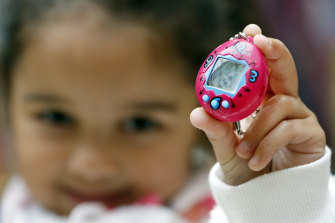London: They will cuddle you, play with you and, of course, resemble you. They will require minimal resources and will cost next to nothing to bring up.
But the one catch with these “ideal children” is that they are, in fact, not human, but a virtual creation which an artificial intelligence expert predicts will be commonplace in 50 years.
A digital option for future babies.
Catriona Campbell, one of the UK’s leading authorities in AI and emerging and disruptive technologies, made the prediction in a book published this week. In AI by Design: A Plan For Living With Artificial Intelligence, she argues that concerns about overpopulation will prompt society to embrace metaverse-hosted digital babies. It is a demographic transformation she calls the “Tamagotchi Generation”.
“Virtual children may seem like a giant leap from where we are now,” she writes, “but within 50 years technology will have advanced to such an extent that babies… in the metaverse are indistinct from those in the real world.
“As the metaverse evolves, I can see virtual children becoming an accepted and fully embraced part of society in much of the developed world.”
The metaverse is an immersive digital world, seen as the future of the internet, which will be more physically interactive. Campbell says technology such as high-tech gloves might reproduce the physical sensations of cuddling, feeding and playing with one’s offspring.
Tamagotchi is a virtual electronic animal which means “cute little egg” and simulates the life of an animal.Credit:Getty
She cites widespread concern about the environmental toll exacted by the world’s increasing population, which is nearing eight billion.
A 2020 YouGov study found nearly 10 per cent of couples remain childless because of overpopulation concerns, while a further 10 per cent choose not to start a family because of the cost.
Many researchers now believe that declining fertility rates will cause the world’s population to fall in the second half of the century, and some argue that technological advances will ensure that the next generation’s environmental footprint is smaller than our own.
Campbell argues that consumers will be attracted to environmentally friendly digital children.
Referring to the virtual pets that became a craze in the late Nineties and early 2000s, she said: “We’re already well on our way to creating the Tamagotchi Generation which, for all intents and purposes, will be ‘real’ to their parents. On the basis that consumer demand is there, which I think it will be, AI children will become widely available for a relatively small monthly fee.
“This development, should it take place, is a technological game-changer which, if managed correctly, could help us solve some of today’s most pressing issues, including overpopulation.”
Campbell said that, through CGI and advanced machine learning, digital children will have photo-realistic faces and bodies, and that they will be able to recognise and respond to their “parents” using facial tracking and voice analysis. They will be capable of speech and simulated emotional responses encompassing a baby’s coo, a child’s giggle and a teenager’s backchat.
Their parents will be able to interact with them in digital environments of their choosing. They will also be able to choose how quickly their digital children grow up, if at all.
To adults, Tamagotchis were pixelated screens mounted on plastic eggs. To the children (and some adults) who owned them, Tamagotchis were beloved pets
First released in Japan in 1996 by the games manufacturer Baidu, Tamagotchis presented their owners with an on-screen egg that hatched into a digital animal. The animation was primitive, but the response was primal. The creatures needed feeding, playing with, and cleaning up after, and they became very popular in Britain in the late 1990s.
A Tamagotchi’s lifespan was about 20 days, and their deaths, accompanied by an animation of the creature fluttering up to heaven, often caused anguish.
Telegraph, London
Most Viewed in World
From our partners
Source: Read Full Article




